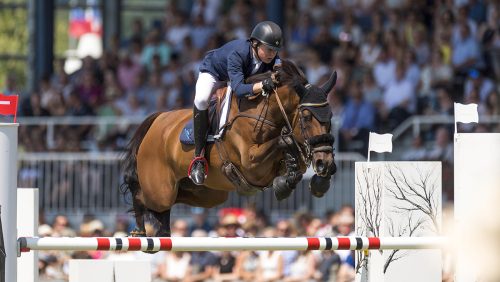For Denny Emerson, life, as he likes to say, has always been a matter of “I’m gonna,” not “I wanna.”
Back in the summer of 1961, he resolved to master the sport of three- day eventing. He had just finished his sophomore year at Dartmouth College (N.H.), and his childhood riding friend Alan Leslie invited him to go see the Wofford Cup National Three-Day Championship at Groton House Farm in Hamilton, Mass. Emerson knew nothing about the sport, but he went along, ever game for a new adventure.
“It was amazing,” recalled Emerson. “It showed me a dimension of riding I didn’t know existed. There was a jump on cross-country, a big slide with a jump halfway down it. I thought, ‘I can’t do that. I don’t know how to do that.’ Basically, it pissed me off, because I thought, ‘If I can’t do that, it means I’m not as great a rider as I thought I was.’ ”
He considered it a challenge rather than an obstacle. “I decided literally that day that I was going to learn to do three-day eventing and win a gold medal,” he said.
Now 75, an inductee into the U.S. Eventing Association’s Hall of Farm and recipient of the USEA Wofford Cup, he reflected on his naïve attitude: “You’re so stupid when you’re a kid. But you can translate some of that stupidity and arrogance into action. I always had initiative.”
A Free-Range Chicken
Born Aug. 20, 1941, Emerson fell in love with horses as a youngster listening to “The Lone Ranger” on the radio and reading comic books featuring the escapades of Roy Rogers, Tom Mix and Gene Autry.
“I was vicariously a horse person,” he said. “I loved the romance of horses.”
ADVERTISEMENT
His chance to experience horses first hand came in 1950 when his father was named headmaster of the Stoneleigh-Prospect Hill School (now Stoneleigh-Burnham) in Greenfield, Mass. The school had a riding program, and Emerson quickly became a “barn rat” spending all his time in the barn, building forts in the hayloft and messing around with the horses. He was determined to get a pony of his own, and when he saw a local horse dealer’s ad in the newspaper he persuaded his parents to buy him one. He ended up with what the dealer described as a “kid broke hoss,” a pinto pony he named Paint.
“My parents paid $200 for the western saddle, bridle, the whole deal,” he said.
Emerson rode Paint mostly bareback, with just a halter and lead rope with snaps at both ends. “I’d go out to the pasture and climb on. There was no Interstate 91 back then,” he said, refer- ring to the highway that winds up the Connecticut River Valley. “So you could ride through the woods and eventually hit a road that would take you all the way to Vermont.” As a child, he said, he was “a pretty free-range chicken. Parents just turned you loose. They didn’t have a clue where you were.”
His family couldn’t afford riding lessons or fancy horses, but his ambition was evident to Francis Kinsman, the Stoneleigh barn manager, who had a homemade, wooden one-horse trailer. On weekends, Kinsman took Emerson and Paint around the New England countryside to ride in western-style gymkhanas.
“That’s how I got started competing,” Emerson said. “We’d do pole-bending, egg-and-spoon races, that kind of thing. Growing up bareback you get to be a pretty good rider without having lessons or anything.”
After outgrowing Paint in 1955, Emerson graduated to a horse called Bonfire. “One day in the Stoneleigh library I saw the GMHA magazine,” he recalled, referring to the Green Mountain Horse Association in South Woodstock, Vt. “There was an article in it about GMHA’s 100-mile endurance race. I decided to do it on Bonfire.”
His “I’m gonna” attitude kicked into gear once again. “I knew zero about conditioning horses,” he said. “But I wrote to GMHA for an entry.”
The following fall, at age 15, he completed the ride. “I always went on the premise that it didn’t matter if I didn’t know anything about it. I’d just plunge in and learn on the job. I just did it,” he said.
ADVERTISEMENT
Emerson became interested in Morgans in his early teens, when he attended the National Morgan Horse Show in Northampton, Mass. He got his first Morgan, Lippitt Sandy, in 1956 and rode Morgans throughout his teens in endurance rides and horse shows.
Practice, Practice, Practice
Then came Emerson’s momentous 1961 trip to Groton House, after which he bought a Thoroughbred gelding named Lighting Magic. He soon realized there were some gaps in his horsemanship.
“In my quest to become a great event rider and win a gold medal, I had to learn to jump,” he said.
This is an excerpt from the article “Denny Emerson: Living Legend” by Mickey Rathbun, which appears in the Jan. 30 Master Class issue of The Chronicle of the Horse. If you’d like to read the article in its entirety, you can subscribe and get online access to a digital version and then enjoy a year of The Chronicle of the Horse and our lifestyle publication Untacked. Or you can purchase a single issue or subscribe on a mobile device through our app The Chronicle of the Horse LLC.
If you’re just following COTH online, you’re missing so much great unique content. Each print issue of the Chronicle is full of in-depth competition news, fascinating features, probing looks at issues within the sports of hunter/jumper, eventing and dressage, and stunning photography.















